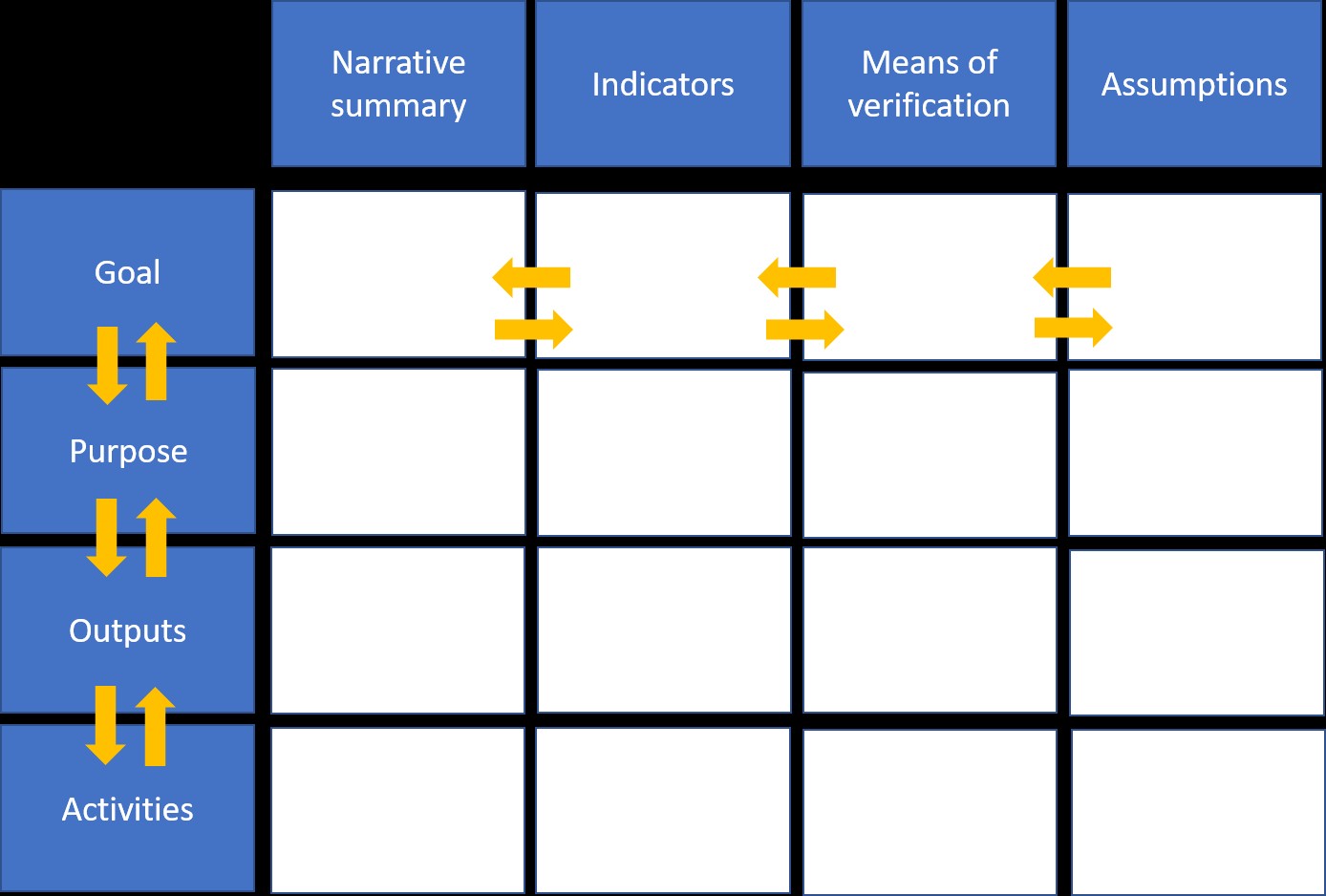Project management in international aid and development requires robust tools. For many organizations, including USAID, UK and Swedish aid agencies, and the European Commission, the Logical Framework Approach, often visualized through a “logframe,” is a cornerstone. Donors frequently mandate this approach for grant applications, highlighting its significance in the sector.
Having recently completed an insightful course on logframe planning with The Open University, I was motivated to delve deeper into its advantages, disadvantages, and ongoing evolution. This article shares these findings, offering a comprehensive overview for both newcomers and those familiar with the tool. We will explore what a logframe is, how it’s constructed, its recognized benefits and limitations, and briefly touch upon its relation to broader project management methodologies, including a nod to resources like the PMBOK® Guide.
What Exactly is a Logframe?
A logframe, short for logical framework, is fundamentally a 4×4 matrix, a table with 16 cells. While the specific format and depth may vary depending on the organization and donor requirements, the core structure remains consistent.
Developed through a process called Logical Framework Analysis, USAID aptly describes it as “a way of thinking about development projects… One-page tool for summarizing key elements of a project design and establish a basis for monitoring and evaluation.”
The diagram below illustrates a typical logframe structure, using terminology common in The Open University course.
This “logic model” operates on two intertwined logics. The vertical logic, flowing from Goal to Activities, embodies the project’s analytical and scientific foundation. The Goal (referred to as ‘Overall Objective’ by the EC or ‘Impact’ by the UK FCDO) represents the overarching aim of the project – its ultimate intended achievement. The Purpose (or ‘Outcome’ for FCDO) defines what the project will accomplish and who will directly benefit. Outputs are the tangible results the project will generate. Finally, Activities (or ‘Inputs’ for USAID) are the necessary tasks to produce the outputs.
The horizontal logic governs project management and accountability. The Narrative Summary offers a concise description of project objectives. Indicators are the metrics used to measure project success. Means of Verification (or ‘Data sources’ for USAID) detail how indicator data will be collected. Lastly, Assumptions are the external conditions critical for achieving the intended results.
“The logframe is a visual summary of your project, which can be shared to explain what you intend to do and why. It also explains how you will measure the changes your work will deliver, and the sources of information you will use to do this measurement.”
Tearfund
Building a Logframe: A Collaborative Process
Creating a logframe is not a one-size-fits-all process. It’s influenced by project complexity, organizational size, project scope, and the specific requirements of the sponsoring organization. References at the end of this article provide links to detailed resources.
Generally, a logframe should logically emerge from a thorough process. This includes a comprehensive problem analysis, often employing “objective tree” analysis or “Theory of Change” principles. The core principle is a “cause-and-effect” logic, forming the framework’s bedrock.
Logframe development should be a collaborative and iterative endeavor, involving all stakeholders: the project organization, partners, sponsoring bodies, and project participants. Tearfund emphasizes that “The best logframes are ones where stakeholders have had the chance to be involved and that use an approach that encourages people to participate.” This inclusive approach ensures diverse perspectives are considered, fostering a shared understanding of project components and expected outcomes. This, in turn, improves buy-in, aiding project execution and monitoring.
Tearfund proposes a three-stage process:
- Top-down – Statements: Complete the ‘statements’ column first.
- Bottom-up – Assumptions: Develop assumptions using an ‘if-and-then’ logic approach (see diagram).
- Work-across – Indicators and verification: Define indicators (what to measure) and means of verification (how to measure) for each objective. Refer to Tearfund’s publication for a detailed explanation of their approach.
Crucially, the chosen process and methodology should be user-friendly for all stakeholders. It must also facilitate easy adjustments as projects evolve, new insights emerge, and the project context shifts. This adaptability is critical for the logframe to remain a relevant and useful tool throughout the project lifecycle, mirroring the iterative nature of project management principles found in resources like the PMBOK® Guide.
Are Logframes Always Effective? Benefits and Limitations
Logframes have contributed to numerous successful projects globally for decades. However, they have also faced scrutiny, with questions raised about their effectiveness. This is understandable, given that Logical Framework Analysis originated in the early 1970s. Let’s examine the perceived strengths and weaknesses.
Tearfund, among others, highlights several key benefits of logframes:
- Promoting organized and logical thinking in project design.
- Identifying weaknesses in project plans early on.
- Ensuring early identification of measurable elements, facilitating monitoring and evaluation.
- Establishing a common terminology for all project stakeholders.
- Enabling concise project summaries, improving communication of project ideas.
However, Tearfund also acknowledges limitations:
- Logframes are most effective for projects with clear, visible outcomes and simple linear logic (“if-and-then”).
- They can oversimplify projects, which are often non-linear in reality.
- Logframe rigidity can hinder project management unless treated as a living document (which can be time-consuming).
- Problem-focused approach may be unsuitable in cultures where open problem discussion is uncommon.
- Complexity of the approach can be difficult to grasp in certain cultural contexts.
- Inconsistencies in terminology, formats, and templates across different donors can cause confusion.
Gasper’s review points to three recurring failures that can undermine project performance and limit logframe potential:
- LOGIC-LESS FRAME: Logframes become a perfunctory exercise when imposed by donors, often created post-project design. Gasper argues this creates “only an illusion of logic” as the format is retrofitted to an existing design, rather than guiding logical design from the outset.
- LACK-FRAME: Logframe simplification can omit crucial project aspects, as a single table cannot capture every important detail.
- LOCK-FRAME: Initial logframes can become static, hindering adaptation and learning. Oversimplified plans are then treated “as blueprints that dictate outcomes“, becoming rigid control tools, preventing necessary flexibility.
Furthermore, a 2006 PMI review compared the European Commission’s Project Cycle Management (PCM), which includes Logical Framework Analysis, with international project management standards (PMBOK® Guide, IPMA’s ICB, ISO 10006) and methodologies (PRINCE2, TenStep®). The review concluded that PCM/LFA excels in defining and managing program and project aspects like lifecycle, design, procurement, monitoring & evaluation, indicators & metrics, and budgets. However, it lacks depth in critical areas like human resource and team management, quality management, risk monitoring, complex scheduling, issue management, organizational aspects, and robust project approval and control procedures. Essentially, relying solely on a logframe is insufficient for project success without supplementary procedural interventions, particularly those outlined in comprehensive guides like the PMBOK® Guide.
Conclusion: Logframes as Part of a Broader Toolkit
Logframes have been instrumental in impactful projects worldwide for decades. They are valuable tools for project thinking, and like all project management tools, their effective use demands training and disciplined application. While logframes may not be universally applicable or address all facets of project management, their structured approach to planning and logic remains beneficial.
Projects today are increasingly complex, operate in ill-defined contexts, and often lack simple cause-and-effect relationships. This complexity is recognized, and logframe variations are emerging. Reports, like one commissioned by FASid, explore approaches such as ‘Outcome Mapping and Social Network Analysis’ alongside Project Cycle Management. These newer methodologies bridge the logical framework approach with more recent methods designed for complex situations.
Organizations using logframes should be mindful of their limitations and stay informed about model refinements. This ensures logframes remain effective and fit-for-purpose tools. The ongoing evolution of project management methodologies, as reflected in resources like the PMBOK® Guide, underscores the need for continuous learning and adaptation in this field.
For me, the exploration of recent model evolutions is a new frontier… I hope this overview has been insightful and useful. As always, your comments and constructive feedback are welcome.
Marco Bottacini, Senior Portfolio Manager, GALVmed
Useful references
The views and opinions expressed in this blog are those of the author and do not necessarily reflect the views and opinion of GALVmed.
Like Loading…

